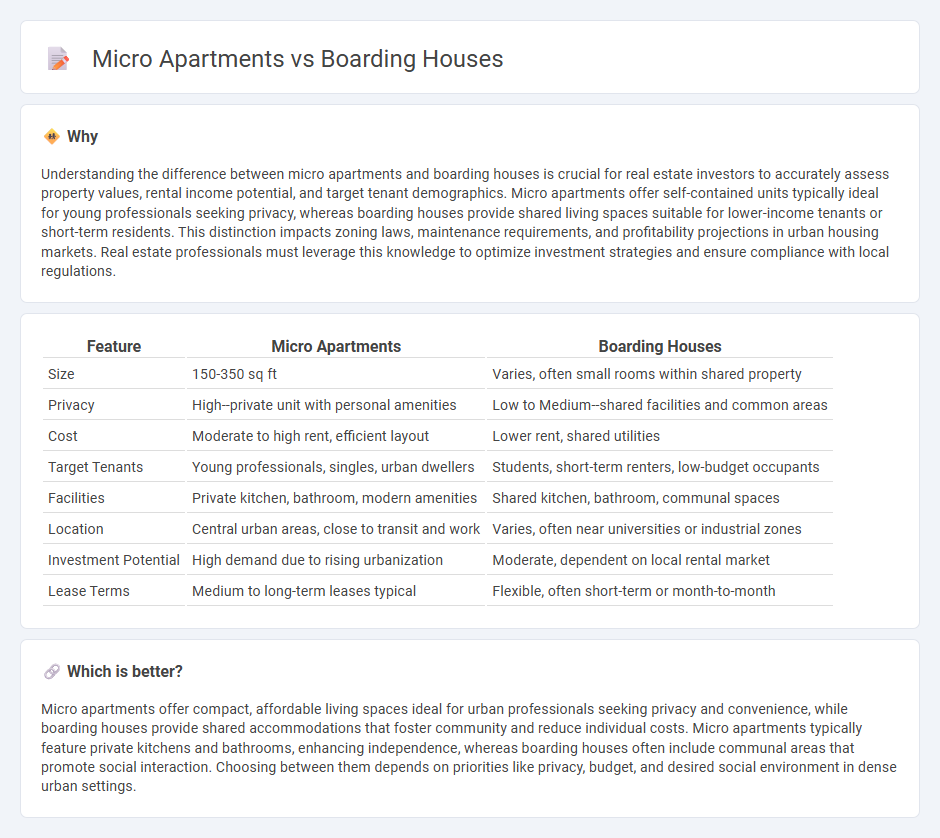
Micro apartments maximize urban living by offering compact, efficient spaces tailored for affordability and convenience in high-demand areas. Boarding houses provide shared accommodations with communal facilities, catering to individuals seeking social interaction and lower rental costs. Explore the benefits and drawbacks of micro apartments versus boarding houses to find the ideal housing solution for your needs.
Why it is important
Understanding the difference between micro apartments and boarding houses is crucial for real estate investors to accurately assess property values, rental income potential, and target tenant demographics. Micro apartments offer self-contained units typically ideal for young professionals seeking privacy, whereas boarding houses provide shared living spaces suitable for lower-income tenants or short-term residents. This distinction impacts zoning laws, maintenance requirements, and profitability projections in urban housing markets. Real estate professionals must leverage this knowledge to optimize investment strategies and ensure compliance with local regulations.
Comparison Table
| Feature | Micro Apartments | Boarding Houses |
|---|---|---|
| Size | 150-350 sq ft | Varies, often small rooms within shared property |
| Privacy | High--private unit with personal amenities | Low to Medium--shared facilities and common areas |
| Cost | Moderate to high rent, efficient layout | Lower rent, shared utilities |
| Target Tenants | Young professionals, singles, urban dwellers | Students, short-term renters, low-budget occupants |
| Facilities | Private kitchen, bathroom, modern amenities | Shared kitchen, bathroom, communal spaces |
| Location | Central urban areas, close to transit and work | Varies, often near universities or industrial zones |
| Investment Potential | High demand due to rising urbanization | Moderate, dependent on local rental market |
| Lease Terms | Medium to long-term leases typical | Flexible, often short-term or month-to-month |
Which is better?
Micro apartments offer compact, affordable living spaces ideal for urban professionals seeking privacy and convenience, while boarding houses provide shared accommodations that foster community and reduce individual costs. Micro apartments typically feature private kitchens and bathrooms, enhancing independence, whereas boarding houses often include communal areas that promote social interaction. Choosing between them depends on priorities like privacy, budget, and desired social environment in dense urban settings.
Connection
Micro apartments and boarding houses both address the urban housing shortage by providing compact, affordable living spaces in high-demand areas. These housing models maximize limited real estate through shared amenities and efficient design, appealing to young professionals and transient residents. Their growing popularity reflects shifting preferences toward cost-effective, flexible urban living solutions.
Key Terms
Shared Facilities
Boarding houses offer communal kitchens, laundry areas, and social spaces that foster a strong sense of community among residents. Micro apartments provide private living units with limited or no access to shared amenities, emphasizing personal space and independence. Explore the key differences in shared facilities to determine which housing option suits your lifestyle best.
Unit Size
Boarding houses typically offer units ranging from 100 to 250 square feet, emphasizing shared amenities and affordability, whereas micro apartments provide private living spaces averaging 250 to 400 square feet with compact, fully-equipped layouts. Both options cater to urban dwellers seeking economical housing solutions, but micro apartments prioritize privacy and self-sufficiency through optimized unit size and design. Explore the detailed comparisons on unit size efficiency and lifestyle suitability to determine the best fit for your needs.
Lease Structure
Boarding houses typically operate under short-term or month-to-month leases, offering flexible rental agreements ideal for transient tenants, whereas micro apartments commonly feature standard long-term leases of one year or more, providing stability and tenant protections. The lease structure in boarding houses often includes shared amenities and communal spaces, contrasting with micro apartments where leases cover fully self-contained units with individual utilities and services. Explore the nuances in lease agreements to determine which housing type aligns best with your lifestyle and rental needs.
Source and External Links
Boarding house - A boarding house is a home where lodgers rent rooms often with meals and some services, providing room and board with varying meal options and shared or private facilities, traditionally common in college and tourist towns.
A History of Boarding Houses: Ideal Forms of Affordable Housing - Boarding houses historically offered affordable lodging and promoted social diversity, serving as a precursor to modern short-term rentals such as Airbnb.
What Are Boarding Houses? And How Do They Work? - Boarding houses provide rooms plus meals and services like laundry, often run in private homes, with variations including bed & breakfasts and rentals to foreign students, requiring understanding of local laws.
 dowidth.com
dowidth.com